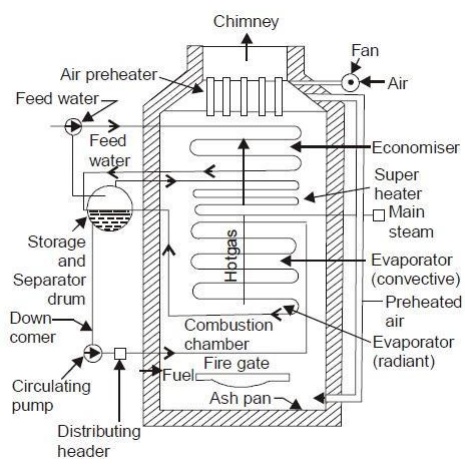Chapter: Mechanical and Electrical : Power Plant Engineering : Power Plants and Boilers
High Pressure Boilers
HIGH PRESSURE BOILERS
A boiler is
a closed vessel in which water or other fluid is heated. The heated or
vaporized fluid exits the boiler for use in various processes or heating
applications.
In all modern power
plants, high pressure boilers (> 100 bar) are universally used as they offer
the following advantages. In order to obtain efficient operation and high
capacity, forced circulation of water through boiler tubes is found helpful.
1.
The efficiency and the capacity of
the plant can be increased as reduced quantity of steam is required for the
same power generation if high pressure steam is used.
2.
The forced circulation of water
through boiler tubes provides freedom in the arrangement of furnace and water
walls, in addition to the reduction in the heat exchange area.
3. The tendency of scale formation is reduced due to high velocity
of water.
4. The danger of overheating is reduced as all the parts are
uniformly heated.
5.
The differential expansion is
reduced due to uniform temperature and this reduces the possibility of gas and
air leakages.
Superheater
operation is similar to that of the coils on an air conditioning unit, although
for a different purpose. The steam piping is directed through the flue gas path
in the boiler furnace. The temperature in this area is typically between 1,300–1,600 degrees Celsius. While the
temperature of the steam in the superheater rises, the pressure of the steam
does not. Almost all the steam superheater systems are designed to remove
droplets entrained in the steam to prevent damage to the turbine blading and
associated piping.
1LA-MONT BOILER
It is a forced circulation- water tube boiler which was first
introduced in 1925 by La
Mont.
The feed water from hot well is supplied to a storage and
separating drum (boiler) through the economizer. Most of the sensible heat is
supplied to the feed water passing through the economizer

The feed water from
hot well is supplied to a storage and separating drum (boiler) through the
economizer. Most of the sensible heat is supplied to the feed water passing
through the economizer. A pump circulates the water at a rate 8 to 10 times the
mass of steam evaporated. This water is circulated through the evaporator tubes
and the part of the vapour is separated in the separator drum. The large
quantity of water circulated (10 times that of evaporation) prevents the tubes
from being overheated.
The centrifugal
pump delivers the water to the headers at a pressure of 2.5 bar above the drum
pressure. The distribution headers distribute the water through the nozzle into
the evaporator. The steam separated in the boiler is further passed through the
super-heater.
To secure a uniform
flow of feed water through each of the parallel boiler circuits a choke is
fitted entrance to each circuit. These boilers have been built to generate 45
to 50 tons of superheated steam at a pressure of 120 bar and temperature of
500°C.
Important Components
1. Steam separating drum – The feed water from the hot well is
stored in the drum. The steam is separated from water in the drum and
the steam is usually collected at the top
of the drum.
2. Circulating pump – Water from the steam separating drum
is drawn by a circulating pump and it circulates water through the
evaporator tubes. Pump circulates water at a rate of 8-10 times the mass of
steam evaporated. Forced circulation is necessary to prevent the overheating of
tubes.
3. Distribution header – The distribution header distributes
the water through the nozzle into the evaporator.
4. Radiant evaporator – Water from the drum first enters the
radiant evaporator through the pump and header. The water is heated by
the radiation heat from the combustion chamber. In radiant evaporator, the hot
flue gases do not pass over the water tubes.
5. Convective evaporator – The mixture of water and steam
coming out from the radiant evaporator enters the convective evaporator
tubes. The hot flue gases passing over the evaporator tubes transfer a large
portion of heat to the water by convection. Thus, water becomes steam and the
steam enters to the steam separating drum.
6. Superheater – The steam from the steam separating
drum enters the superheater tubes where it is superheated by the hot
flue gases passing over them. The superheated steam then enters the steam
turbine to develop power.
7. Economiser – The waste hot flue gases pass
through the economiser where feed water is pre-heated. By pre-heating
the feed water, the amount of fuel required to convert water into steam is
reduced.
8. Air pre-heater – The hot flue gases then passes
through the air pre-heater where the air required for combustion is
pre-heated.
Advantages
1. La-Mont boilers can generate 45 to 50 tons of superheated steam
at a pressure of 120 bar and temperature of 500°C.
2. Drum is of small size.
3. Tendency of scale formation is eliminated due to forced
circulation of water.
Disadvantages
1. Bubbles are formed on the inside of the water tubes and this
bubbles reduce the heat transfer rate.
2. Initial and operating costs are high.
3. Maintenance costs are very high.
Related Topics